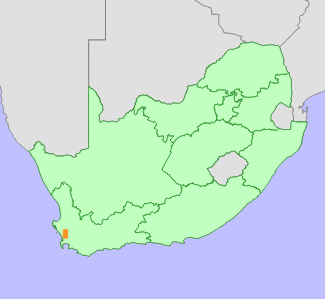|
Scientific Name | Aspalathus rycroftii R.Dahlgren |
Higher Classification | Dicotyledons |
Family | FABACEAE |
National Status |
Status and Criteria | Critically Endangered B1ab(i,ii,iii,iv,v)+2ab(i,ii,iii,iv,v) |
Assessment Date | 2009/07/17 |
Assessor(s) | D. Raimondo, I. Ebrahim & E. Marinus |
Justification | More than 80% of this species' renosterveld habitat is transformed by wheat cultivation and urban expansion of Malmesbury. It was likely formerly more common, but recent surveys located only three subpopulations, one of which was lost to a housing development in 2005. Subpopulations at two remaining locations continue to decline due to alien plant invasion and too infrequent fire. EOO 42 km² and AOO <10 km². |
Distribution |
Endemism | South African endemic |
Provincial distribution | Western Cape |
Range | Malmesbury. |
Habitat and Ecology |
Major system | Terrestrial |
Major habitats | Swartland Shale Renosterveld, Swartland Granite Renosterveld |
Description | Renosterveld in clays on low hills. |
Threats |
| Urban development is a severe past, present and future threat. The locality: Malmesbury commonage "Die Skougronde" was lost to development in 2004.
The Swartland municipality also own the Abbotsdale and the "Triangle" commonages - they have made no commitment to conserving these and both have a high chance of being developed in the next 10 years (D. Raimondo 2006).
Alien invaders such as Acacia saligna and A. cyclops are degrading both of the two remaining localities (moderate past, present and future threat).
Inbreeding due to a lack of seed set may also be a problem. |
Population |
Population trend | Decreasing |
Assessment History |
Taxon assessed |
Status and Criteria |
Citation/Red List version | | Aspalathus rycroftii R.Dahlgren | CR B1ab(i,ii,iii,iv,v)+2ab(i,ii,iii,iv,v) | Raimondo et al. (2009) | | Aspalathus rycroftii R.Dahlgren | Endangered | Hilton-Taylor (1996) | | Aspalathus rycroftii R.Dahlgren | Vulnerable | Hall et al. (1980) | |
Bibliography |
Dahlgren, R. 1988. Crotalarieae (Aspalathus). In: O.A. Leistner (ed). Flora of southern Africa 16 Fabaceae, Part 3 Papilionoideae, Fascicle 6:1-430. National Botanical Institute, Pretoria.
Goldblatt, P. and Manning, J.C. 2000. Cape Plants: A conspectus of the Cape Flora of South Africa. Strelitzia 9. National Botanical Institute, Cape Town.
Hall, A.V., De Winter, M., De Winter, B. and Van Oosterhout, S.A.M. 1980. Threatened plants of southern Africa. South African National Scienctific Programmes Report 45. CSIR, Pretoria.
Hilton-Taylor, C. 1996. Red data list of southern African plants. Strelitzia 4. South African National Botanical Institute, Pretoria.
Raimondo, D., von Staden, L., Foden, W., Victor, J.E., Helme, N.A., Turner, R.C., Kamundi, D.A. and Manyama, P.A. 2009. Red List of South African Plants. Strelitzia 25. South African National Biodiversity Institute, Pretoria.
|
Citation |
| Raimondo, D., Ebrahim, I. & Marinus, E. 2009. Aspalathus rycroftii R.Dahlgren. National Assessment: Red List of South African Plants version 2024.1. Accessed on 2025/10/26 |
 Comment on this assessment
Comment on this assessment


